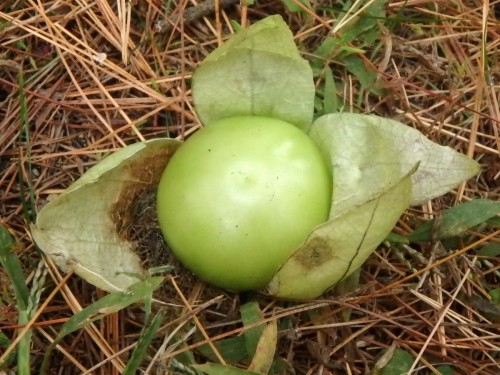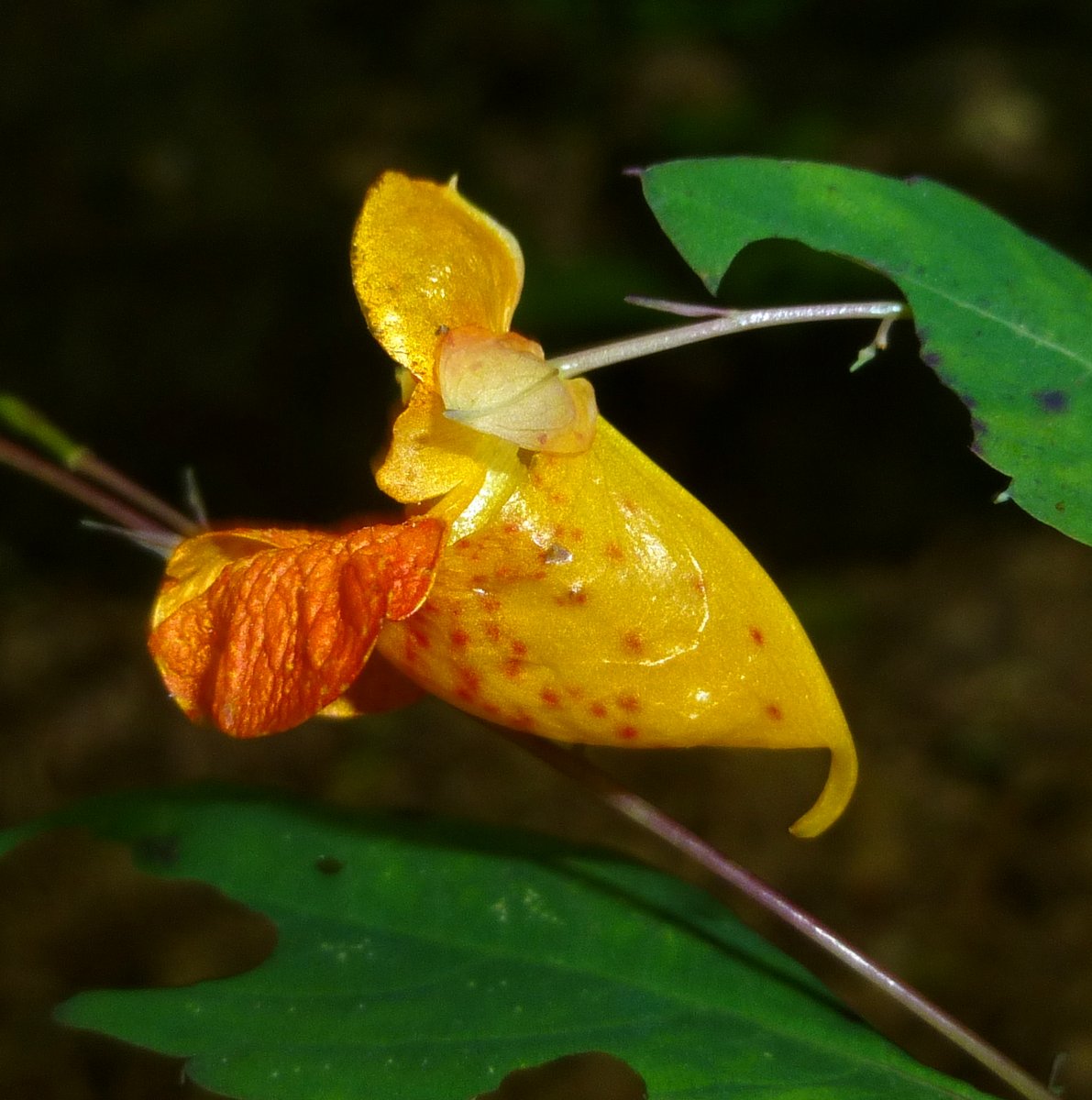
On a recent hot, humid day I thought a rail trail might be a rather effortless walk so I chose one I knew well. When I started walking here some 50+ years ago trains ran through what now looks like a jungle. The railroad would never have put up with so much growth on the sides of the railbed of course, but I kind of like it this way. I was to find out that a little bit of everything grows here now, and the time spent here was full of discovery. This trail has become popular with bicyclists and I was passed by quite a few.
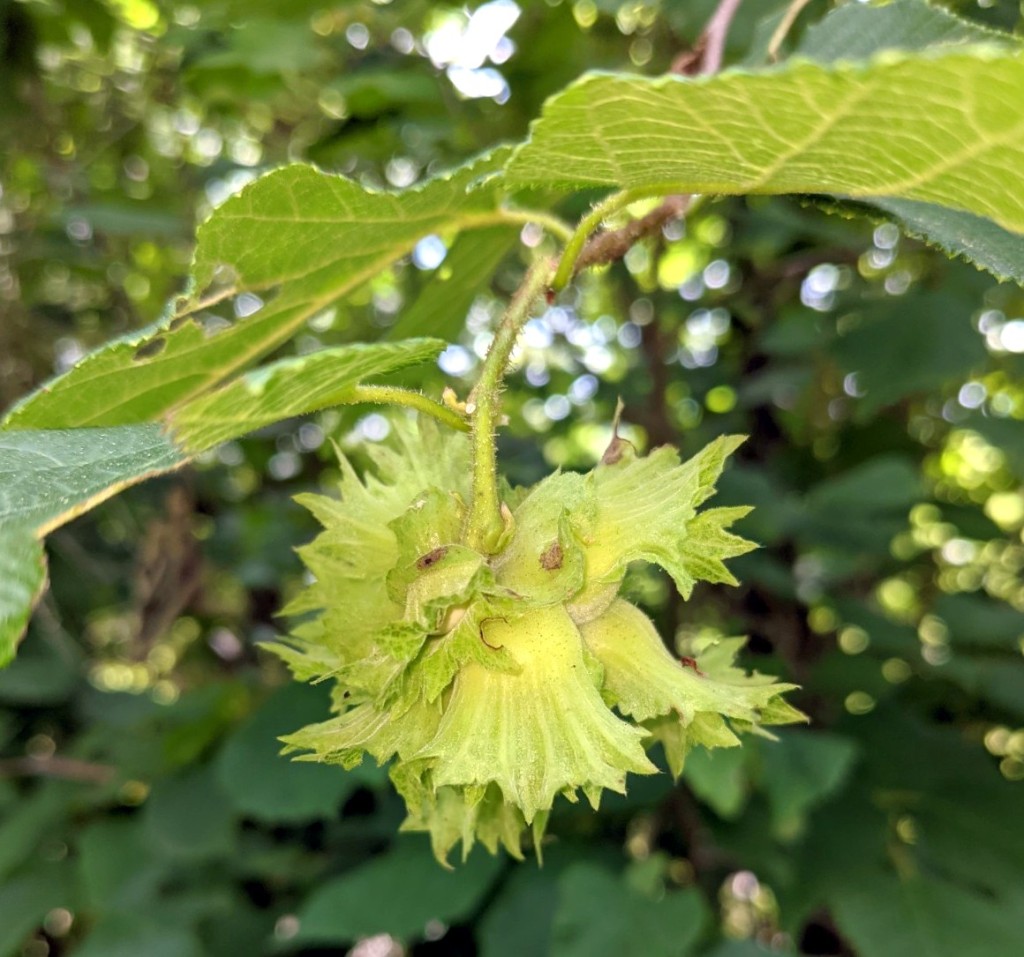
I saw lots of hazelnuts (Corylus americana.) Hazelnuts are a common sight along our rail trails but they have good years and bad years and more often than not there are no nuts on the bushes. On this day though, they were everywhere.

If you turn the nut cluster and look at the back you can see and feel the unripe nuts inside. There were four in this cluster.

Fringed loosestrife grew in shaded places along the trail. Note how virtually every flower nods toward the ground. As far as I know this is the only one of our yellow loosestrifes with this habit. Whorled loosestrife looks identical at a glance, but its flowers face outward.

A vine I never saw when I was a boy and saw only in one spot just a few years ago is spreading enough so now I’m seeing it almost everywhere I go. It is the smooth carrion flower vine (Smilax herbacea.) This native, non woody vine gets its common name from the strong odor of its flowers. There are both male and female plants, and they usually grow near each other.
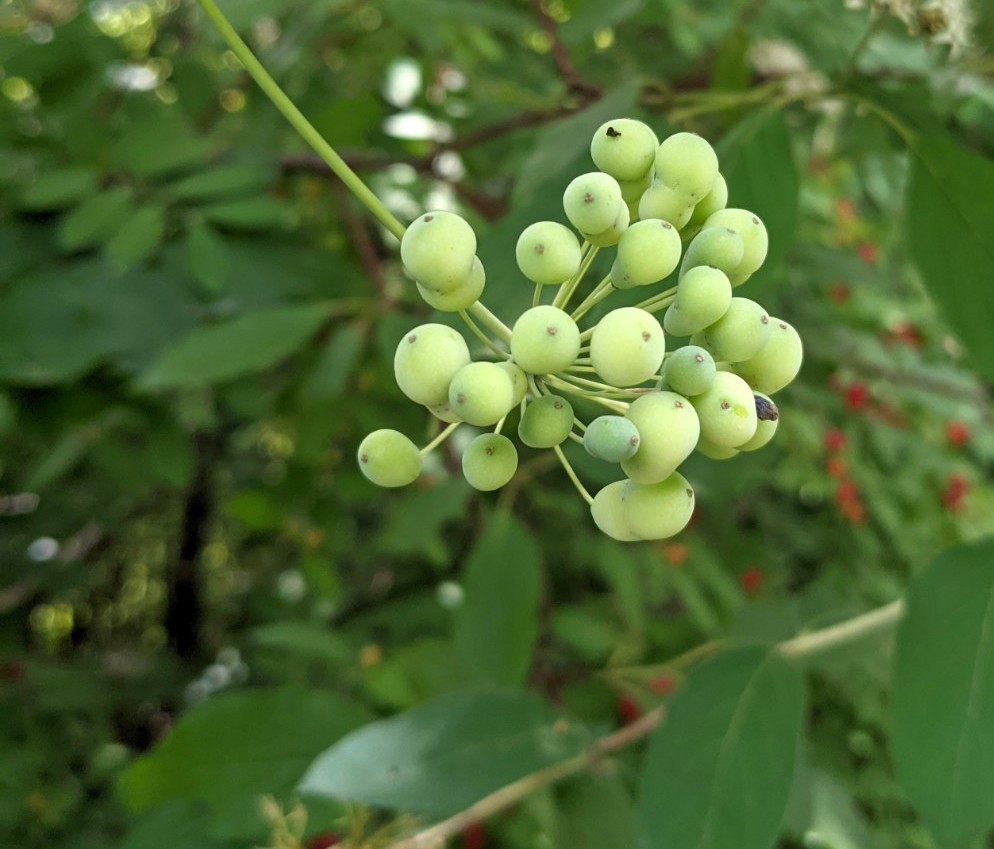
The flowers of the smooth carrion flower vine become dark blue berries that birds love and I would guess that accounts for it quickly spreading from place to place as it has. The berries on this vine were still green but I would guess that they’ll be ripe by the end of July.
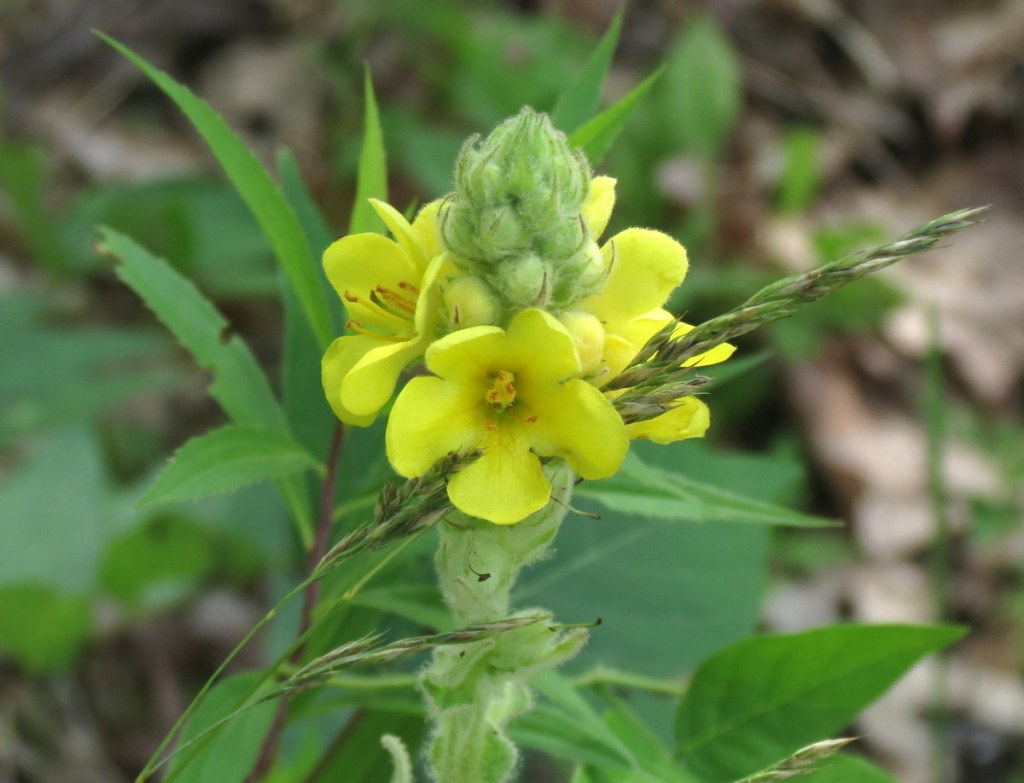
Common mullein surprised me by growing along the trail. I’ve always wondered if the railroad didn’t spray some type of herbicide along the tracks because you never would have found plants like mullein growing here back when the trains ran. There were an awful lot of raspberries and blackberries back then though, but now all I see are canes with no berries. Raspberries and blackberries bear fruit only on second year canes so I’m guessing the young canes I’ve seen here are being cut. Possibly by a snowmobile trail improvement crew.
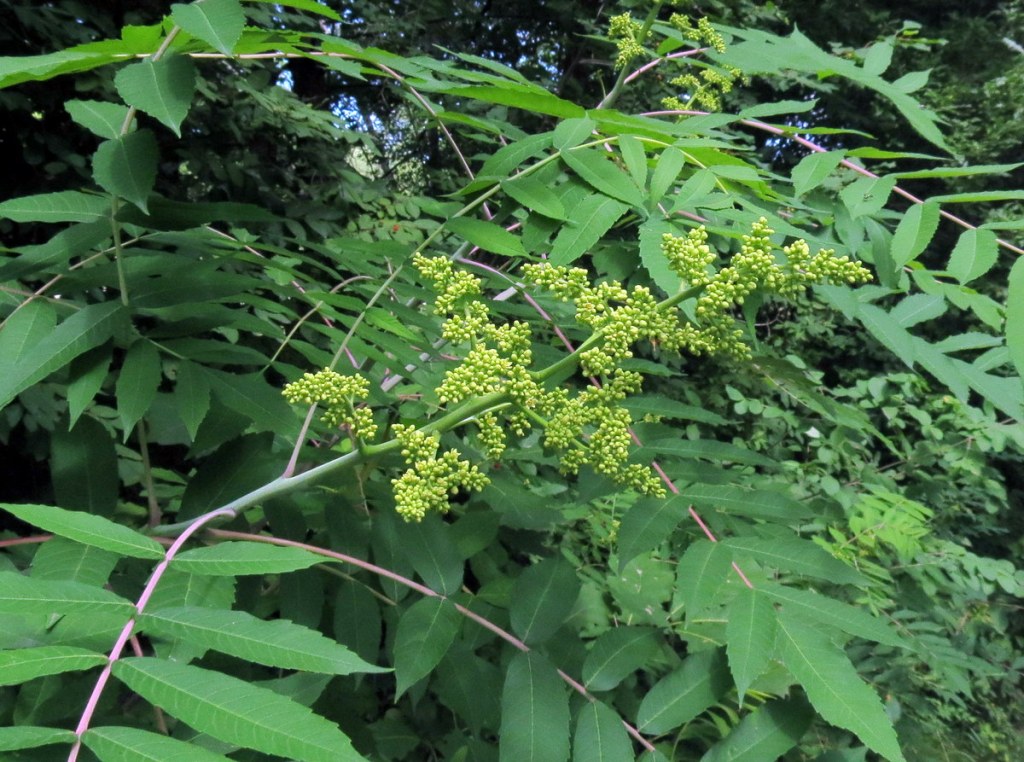
Smooth sumac (Rhus glabra) grew all along the trail and had large flower heads all ready to bloom. You can see how smooth and hairless its stems are in this photo. They are also a bluish color when young. This is another plant I don’t remember ever seeing here when I was a boy.

Here is a smooth sumac flower, just opened. They are so small I really doubted that I’d be able to get a useable photo of them. They look quite complicated for such a small thing.

While smooth sumac was just starting to bloom staghorn sumac (Rhus typhina) had already formed fruit. I didn’t know that sumac berries went from green to pink before they became red.

Some of the things I remember most about this place when I was a boy are the cornfields, most of which are still here. More or less; last years drought killed off the young corn plants and for the first time that I can remember there was no corn growing here. This year in spring I came out here and found wheat growing in this field, as far as the eye could see. Wheat? I didn’t know what that was all about but they’ve cut all the wheat and are leaving this part of the field fallow, apparently. Off in the distance you can just make out corn growing, about a third of the way up in this photo. Why they didn’t plant the whole field I don’t know but the corn that is there was knee high by the fourth of July, and that’s perfect.

Here is the wheat I found a couple of months ago. It is actually triticale according to Google lens, which is a hybrid of wheat (Triticum) and rye (Secale) first developed in laboratories during the late 19th century in Scotland and Germany. If the word triticale (trit-ih-KAY-lee) rings a bell you might have seen an original Star Trek episode called “The Trouble with Tribbles.” Everyone knew what triticale was except captain Kirk, and the tribbles ate all the poisoned triticale and saved the day.

I kept taking photos of the trail because I couldn’t believe how jungle like it has become. I dreamed of being a plant hunter in the world’s jungles when I was young, so I would have loved this. Back then though, this corridor was at least twice as wide.

There are things to watch out for in any jungle and on this day it was stinging nettle (Urtica dioica.) The Urtica part of the scientific name comes from the Latin uro, which means “I burn.” The hollow stinging hairs on the leaves and stems are called trichomes and act like hypodermic needles, injecting histamine and other chemicals that cause the stinging.

Buttery little sulfur cinquefoil (Potentilla recta) likes waste places and disturbed ground so I wasn’t really too surprised to see it here. I was surprised that it got enough sunlight to bloom though.

Tall meadow rue (Thalictrum pubescens) bloomed weakly. Since it starts blooming in June I was surprised to see any flowers at all. I took this shot this way specifically so you could see the plant’s leaves. In early spring a lot of people confuse this plant with wild columbine, though the leaves are quite different.

What surprised me more than anything else I saw was a Canada lily (Lilium canadense) blooming beside the trail. This is something I would have remembered had I seen them here years ago. These plants are one of our biggest wildflowers. They can reach 7 feet tall and have as many as 10 flowers dangling chandelier like from long petioles. This plant only had 2 blossoms and I think it was because it didn’t get enough sun and grew in dry, sandy soil. I’ve seen woodchucks burrow into this ground and all they’ve brought up from under the railbed is pure sand.

Canada lily flowers are big, and can be yellow, orange or red, or a combination. They have purple spotted throats that aren’t always seen because the flowers almost always face downwards. If you’re very gentle though, you can bend a stem back enough to see into a blossom without breaking it. This plant is unusual because it prefers wet places. Most lilies, and in fact most plants that grow from bulbs, do not like soil that stays wet. They prefer sandy, well-drained soil. I almost always find Canada lilies growing along rivers and streams, and that’s why I was so surprised to see it here in this dry soil.

A tiny golden metallic bee landed on a leaf beside me.

The green berries of false Solomon’s seal (Maianthemum racemosum) are now speckled with red. Eventually they’ll become all red and will disappear quickly.

I was surprised to see tall lettuce (Lactuca canadensis) blooming out here. Though it can reach 10 feet tall its flowers are very small; no more than a 1/4 inch across, and appear in loose clusters at the top of wiry stalks. Native Americans used the plant for pain relief, as a stimulant, and for calming the nerves. The milky white sap contains a compound called lactucarium, which has narcotic and sedative properties. It is still used in medicines today but should be used with caution because overdoses can cause death.

There was the trestle over ash brook, where the brook meets the Ashuelot River after it snakes its way through Keene. I usually like to go under it and see what flowers are blooming along the banks of the brook but we’ve had several inches of rain and the water was far too high.
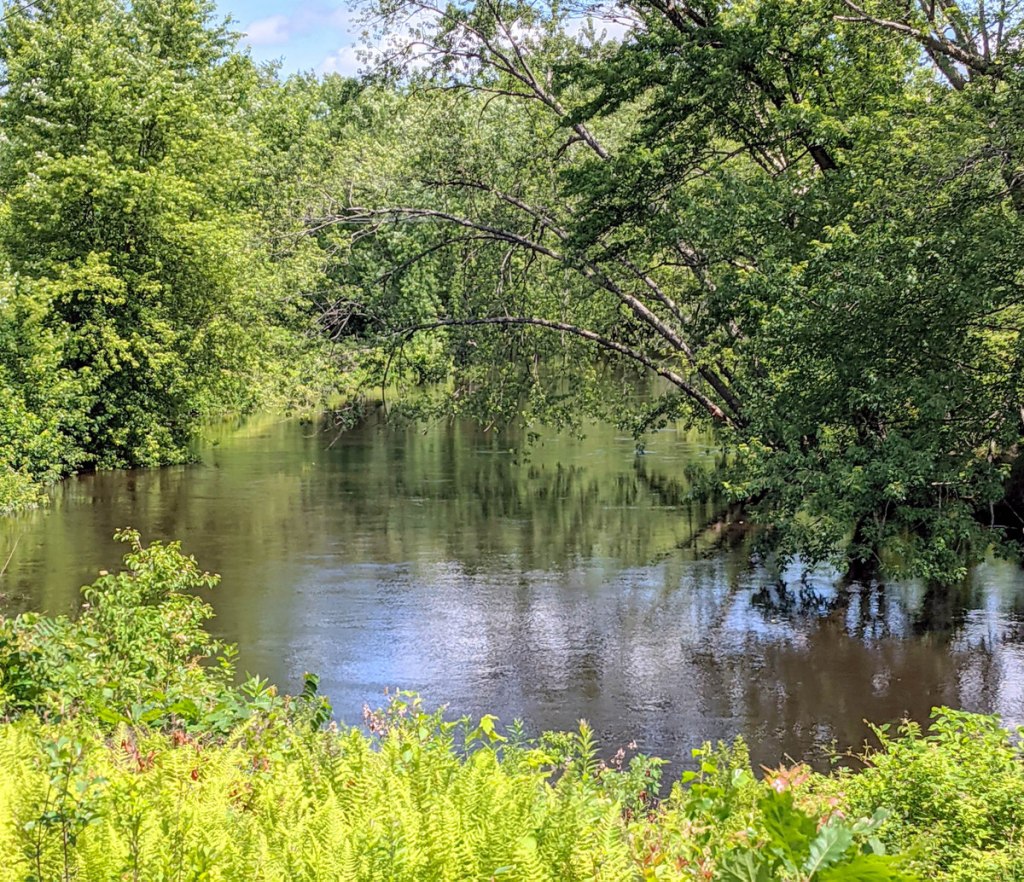
Of course the river was high as well. Not too far from this spot there used to be a small island in the river just off shore, and an oak tree had fallen from the river bank to the island and made a bridge. I used to spend many happy hours on that island but high water like that which we see here first washed away the oak tree bridge and then over the years the island disappeared as well. Water is a powerful thing.

This is a magical place for me. It’s a place where I can see, better than anywhere else, how the world has changed. Or at least this small part of it. The land in this view for instance was a cornfield when I was a boy. Now it’s just silver and red maples and a lot of sensitive ferns; all plants that don’t mind wet feet. If you walk through here you find that the surface soil is pure silt, as fine as sifted flour, and that makes me think they probably stopped farming this piece of land because of flooding. Both the brook and the river still flood in this area and since as I write this on July 11 there are rain or showers predicted every day for the coming week, it’s liable to flood again.
Rest is not idleness, and to lie sometimes on the grass under trees on a summer’s day, listening to the murmur of the water, or watching the clouds float across the sky, is by no means a waste of time. ~John Lubbock
Thanks for stopping in.


















